Why Vik Is a Must-Stop on Your Iceland Campervan Adventure
If you’re doing a proper road trip along Iceland’s South Coast and you don’t stop in Vík, you either hate scenic villages with a passion, or are part of some kind of Top Gear style race.
This tiny village might look modest on the map, but it punches way above its weight when it comes to natural wonders, adventure, and Icelandic charm. It’s where black sand beaches meet dramatic cliffs, sea stacks rise from the waves like ancient trolls (spoiler: they are considered ancient trolls), and the original lava show from Lady Lava and Mr Lava Lava themselves.
Oh, and it just so happens to sit in one of the most photogenic spots in all of Iceland. Add in easy access to Game of Thrones hiking spots, waterfalls, glaciers, and ziplines, and Vík becomes less of a stop and more of a home base for your South Coast campervan itinerary.
Quick Overview: Vik’s Unique Charm, Wildlife & Location
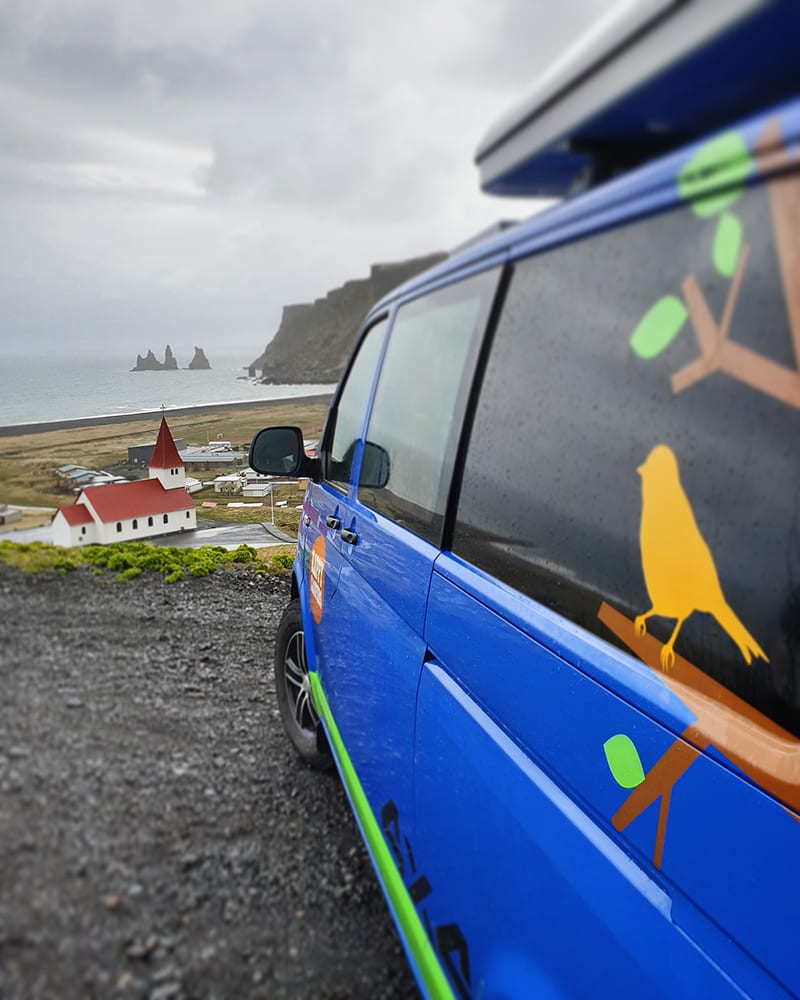 Birthday pizza views at Vik
Birthday pizza views at Vik
Vík í Mýrdal is the southernmost village in Iceland, nestled snugly between the mighty Mýrdalsjökull glacier and the ever-moody Atlantic Ocean. Despite having fewer than 400 residents, this village is far from sleepy. It’s a popular hub for road trippers and adventurers alike, thanks to its jaw-dropping scenery and close proximity to some of Iceland’s most iconic attractions otherwise found on a postcard or desktop background (my Dad likes to let me know every time he sees it…).
This includes black sand beaches, glacier hikes, dramatic sea cliffs, and caves carved out by ancient ice, as well a fantastic array of other lesser-known spots as well (if you like Star Wars, you’re in for a treat, especially).
The setting is pure Icelandic theatre. Towering cliffs hug the coastline, puffins nest in the rocky outcrops, and waves crash against basalt sea stacks that continue to carve into these great trolls of old. And let’s not forget the town itself, which, despite its size, has great food, cosy places to stay, and some of the coolest experiences around.
Whether you’re hiking, beachcombing, zip-lining, or just watching the clouds dance over the nearby glacier with a giant active volcano bubbling beneath the surface (you’ll be fine…I hope), Vík is where Iceland’s wild heart beats loudest, and a place where you’ll need more time than you think, in my opinion.
Getting There & Getting Set
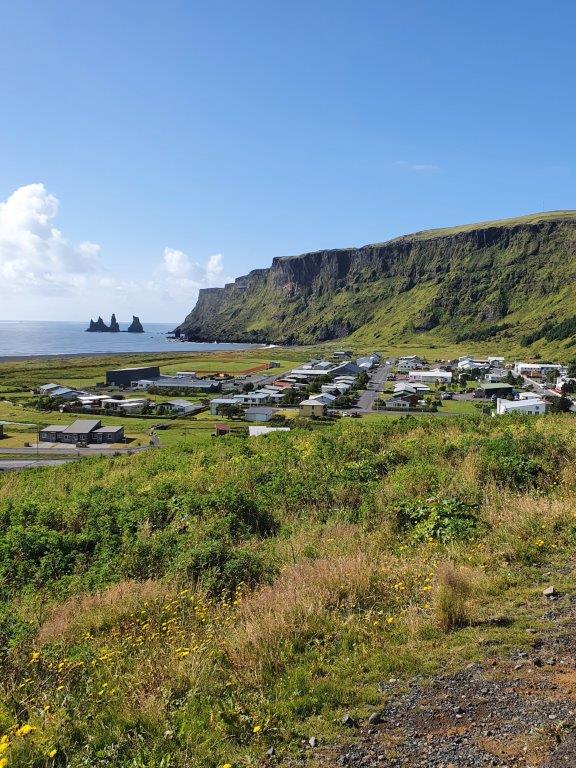
How to Get to Vik by Campervan: Routes, Stops & Timing
The drive from Reykjavík to Vík takes about 2.5 to 3 hours if you don’t stop. But let’s be honest, you’re definitely going to stop. This stretch is packed with epic detours like Seljalandsfoss and Skógafoss, both perfect for stretching your legs and making your Instagram followers jealous. And, don’t forget Kvernufoss waterfall if you’re after that extra privacy with your waterfalls (Bring a picnic also!).
You’ll cruise along Route 1 (otherwise commonly known as ‘the Ring Road’), which is paved, well-marked, and loaded with jaw-dropping views from waterfalls to lava fields, glaciers, fjords, and more. Just watch out for those sneaky speed cameras and occasional sheep that have zero respect for right of way. You should be following the speed limit either way, but just a heads up, the South Coast of Iceland has the most police speed checking officers (just saying).
Best Time to Visit Vík: Weather, Seasons & What to Expect
Vík is open for adventure all year long, but each season paints a different picture. Summer (June to August…or when Iceland decides it is) delivers long daylight hours of the midnight sun, green hills, puffin parades, and road conditions that make driving a breeze. It’s peak season for a reason, with the best chance of good weather and fully accessible highland roads – for the latter you will need a 4WD camper (fortunately, we’ve got you covered there my friend!)
Winter (November to March..Spring is basically a month) flips the script. During this time of year you can expect frozen waterfalls, snow-capped cliffs, and the Northern Lights putting on a light show almost every night – it goes great with a dip in a hot tub. The roads can be trickier, but the reward is having places like Reynisfjara all to yourself (and maybe a curious Arctic fox if you’re lucky).
Spring and autumn are your sweet spot for balance. Fewer tourists, more affordable campervan rentals, and changing landscapes that go from icy blue to mossy green quicker than you can say “skyr.” You’ll need to pack layers, a good waterproof jacket, and plenty optimism…maybe you’re phone as well, of course. Definitely check out our Iceland packing guide before you zip up your suitcase. It might just save your trip, or at least stop you from cursing my name in a snowstorm.
Where to Park or Camp in Vik with a Campervan
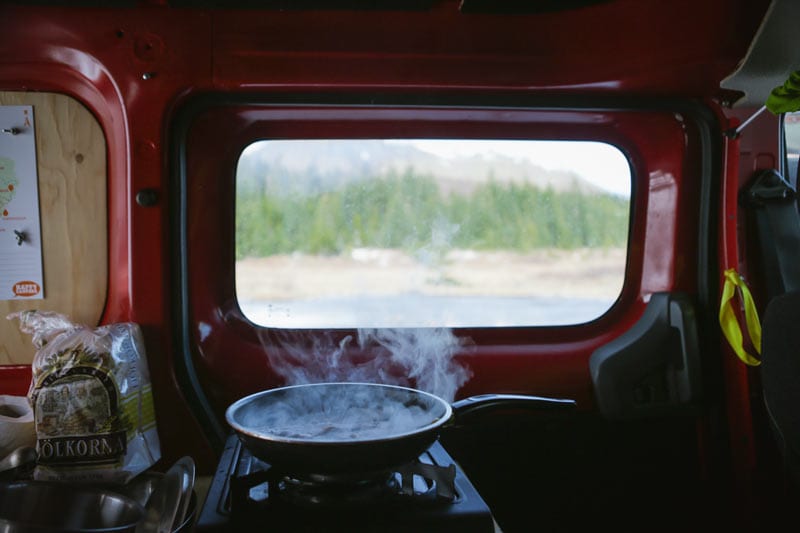
The Vík Campsite is conveniently located right in the heart of the village, offering stunning views of surrounding cliffs and easy walking access to the beach (yep, it’s black sand), restaurants, and local attractions. It’s a fantastic base for exploring everything from Reynisfjara to the Katla Ice Cave without having to move your campervan every time you want to pop out.
Facilities include electric hookups, toilets, coin-operated hot showers, a covered cooking area, and waste disposal. There’s even a small play area if you’re travelling with kids. It’s open seasonally from May through September and gets booked up quickly in peak summer months, so arriving early or calling ahead is highly recommended.
Winter camping here is possible but requires preparation. Not all amenities may be available outside the summer season, and snowfall can impact road access. If you’re planning a winter stay, check conditions on SafeTravel.is, and consider calling the site directly to confirm availability and access – our team will make sure your campervan is ready with studded tyres, but we still hope you don’t channel your inner Vin Diesel (unless it’s just family, of course).
Top Things to Do in and Around Vik, Iceland
1. Reynisfjara Black Sand Beach & Basalt Columns
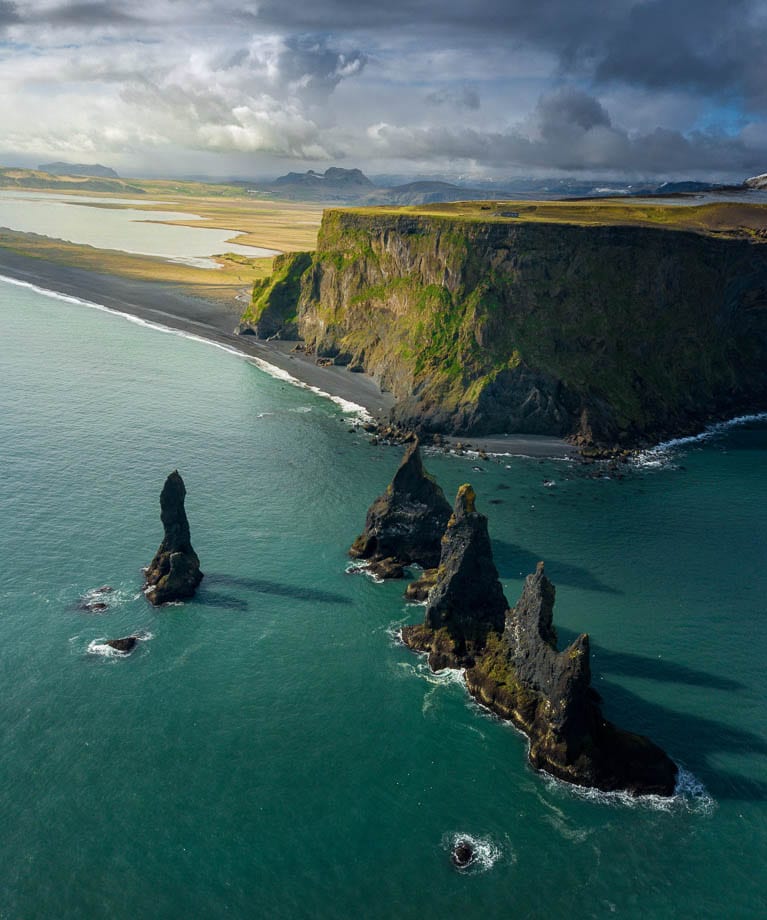
This is the iconic one. Reynisfjara is what happens when Iceland decides to show off. It’s not just a beach, it’s a volcanic statement piece which has fueled Instagram for years with famous Reynisdrangar sea stacks and otherworldly black sand beach.
The black sand is the result of ancient lava flows meeting the sea, cooled into tiny fragments over time. Towering basalt columns rise like nature’s version of organ pipes, formed as lava cooled and cracked into perfect hexagons. These formations have inspired legends and well, Tiktoks alike.
The sea stacks themselves are claimed to be petrified trolls who failed to find refuge from the sunlight after heading out to sea, curious to investigate a recent shipwreck (clearly weren’t following the Reynisfjara black sand beach safety guidelines). Curiosity didn’t kill the cat in this scenario, but it did freeze some trolls – eternity as famous stoned figures does sound better.
Thundering Atlantic waves crash relentlessly onto the shore here, and they come with a warning: sneaker waves. These unpredictable swells can surge up the beach without warning, so keep a safe distance and never turn your back to the sea. You’ll find many videos online of people getting dragged out, and sadly there have been some fatalities over the years.
The beach is well-signed and there’s a convenient car park just a short walk away. You’ll find designated paths to help you safely explore the area, with a traffic light safety guideline to keep you aware of the dangers based on current weather conditions. It’s one of those places where you’ll take a hundred photos and still feel like none of them do it justice. Bring your camera, and maybe a flask of something warm to sip while you take it all in.
2. Dyrhólaey Peninsula: Arch, Lighthouse & Puffin Watching
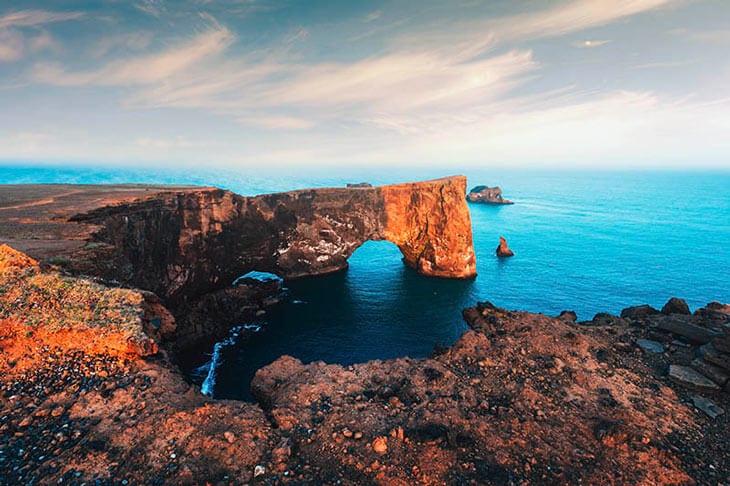
A short drive west from Vík lands you at Dyrhólaey (look right from Reynisfjara beach and you’ll see it towering in the distance), a dramatic promontory known for its sweeping ocean views, towering sea cliffs, and that jaw-dropping natural arch so enormous that boats can sail through it when the tide and conditions allow (cool fact: a plane has managed to dip through the arch whose footage can be seen on Flyover ride in Reykjavík).
At the top, you’ll find a squat little lighthouse that looks like it was imagined during a quirky design challenge on a Wes Anderson film set. It’s whitewashed, charming, and slightly surreal against the raw backdrop of nature.
Come in summer and you’re in puffin territory. These adorably awkward clown birds set up camp in the cliffs here from May to August, shuffling around like they’ve forgotten what wings are for. It’s one of the best and most accessible places in Iceland to spot puffins in the wild, so bring a camera (and maybe a long lens, with some added patience).
The views from Dyrhólaey are nothing short of cinematic. You get a panoramic vista over Reynisfjara’s black sands, the Mýrdalsjökull glacier in the distance, and, on clear days, you can even spot the Westman Islands on the horizon.
3. Yoda Cave: A Cinematic Surprise in South Iceland
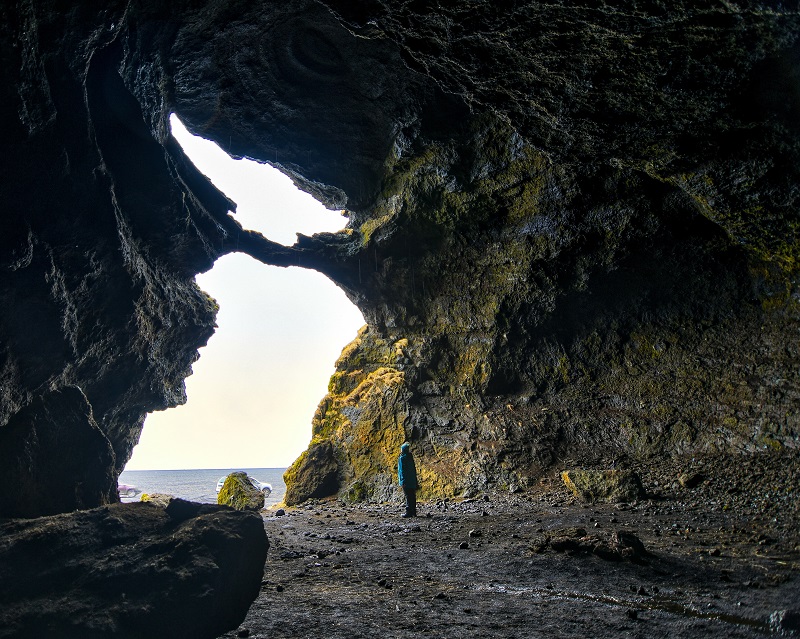
Time for some geekery that I promised at the start of this guide. There’s a new photo op in town, and it’s straight out of a galaxy far, far away. Just east of Vík, tucked at the base of Hjörleifshöfði promontory, lies a natural cave that bears an uncanny resemblance to the face of a certain pointy-eared Jedi master. Known as the Yoda Cave, this hollowed rock formation has become a cult favourite among film buffs, photographers, and anyone who appreciates a touch of the unexpected on their travels.
Getting there is a mini adventure of its own. You’ll follow a bumpy gravel road that winds across a mossy, lunar-looking plain until you reach the base of the hill. From there, it’s a short walk to the cave entrance, which reveals the iconic Yoda-like silhouette best when viewed from the right angle. The inside of the cave is spacious enough to wander and take photos, and the entire area surrounding it feels eerily otherworldly.
The site isn’t officially marked with signs, so having Google Maps or a downloaded offline map comes in handy. And while you won’t find any lightsabers, the view from nearby Hjörleifshöfði offers fantastic panoramas over the coastline and Mýrdalssandur outwash plain. Add this quirky stop to your itinerary and make sure to use the rock at the entrance of the cave to take a unique picture (or dress as a Jedi, why not?)
4. Víkurkirkja Church: History & Emergency Shelter Site
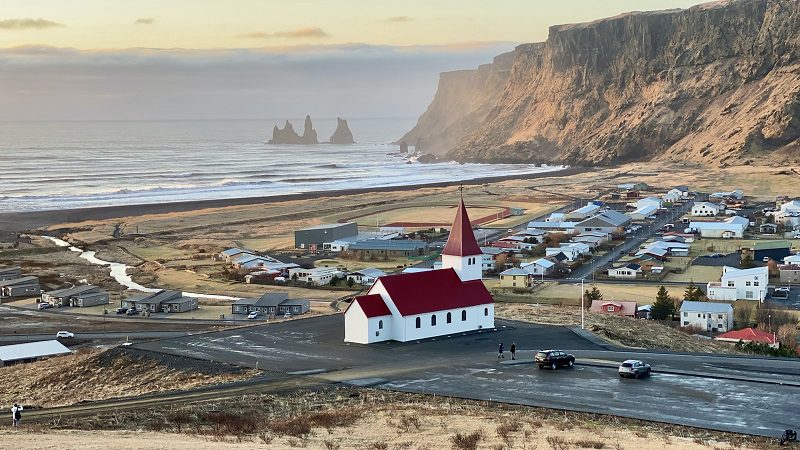
This quaint little church perched on the hill above Vík is one of the most peaceful stops you can make. Built in 1934, Víkurkirkja has stood quietly watching over the village, a calm presence with a big job. It’s also the official emergency evacuation point in case Katla volcano decides to add a little spice to your trip…with an eruption.
The location isn’t just practical; it’s stunning. You’ll get sweeping views of the town below, the dramatic coastline stretching into the horizon, and the iconic Reynisdrangar sea stacks jutting out of the ocean. Whether you’re into drone photography, journalling with a coffee in hand (try one from Skool Beans – a quirky cafe with a 3-legged cat named Jeff in an old school bus), or just soaking up a few quiet moments, this spot is perfect.
It’s peaceful, slightly cinematic, and yes, also the kind of place where you half expect someone to start playing a haunting Icelandic lullaby on a fiddle. If you follow the path behind the church for a few minutes during the summer months you can quietly admire the views a little higher up sat amongst the wonderful lupine plants (that Icelanders for some reason don’t like).
5. Glacier Hiking on Mýrdalsjökull & Sólheimajökull

Lace up your boots, zip up that windbreaker, and down a strong espresso macchiato (yes, like the Eurovision classic), because you’re about to trudge across a frozen world that’s carved the hills and mountain ranges around you since the last ice age. You can join a guided glacier hike on Sólheimajökull or Mýrdalsjökull, two of the most accessible glaciers in southern Iceland, for an unforgettable trek through deep crevasses, ancient ice formations, and streaks of volcanic ash frozen in time.
These guided hikes come with all the gear you need – crampons, helmets, ice axes, the lot, so you won’t need to pack like you’re summiting Everest (though movie quotes are always welcome!) It’s chilly, wildly photogenic, and yes, surprisingly good cardio. Expect the kind of views that make you forget your thighs are burning. And don’t be surprised if your guide casually points out spots where past eruptions reshaped the ice while you literally walking across Iceland’s living, shifting underbelly.
If you visit the glacial tongue of Sólheimajökull you’ll notice the black layer on the glacier which is as a result of ash from the famous 2010 Eyjafjallajökull eruption. At the top your guides will give you the opportunity to sample some glacial water right from the source – it doesn’t get purer than that!
6. Explore the Katla Ice Cave: Accessible All Year
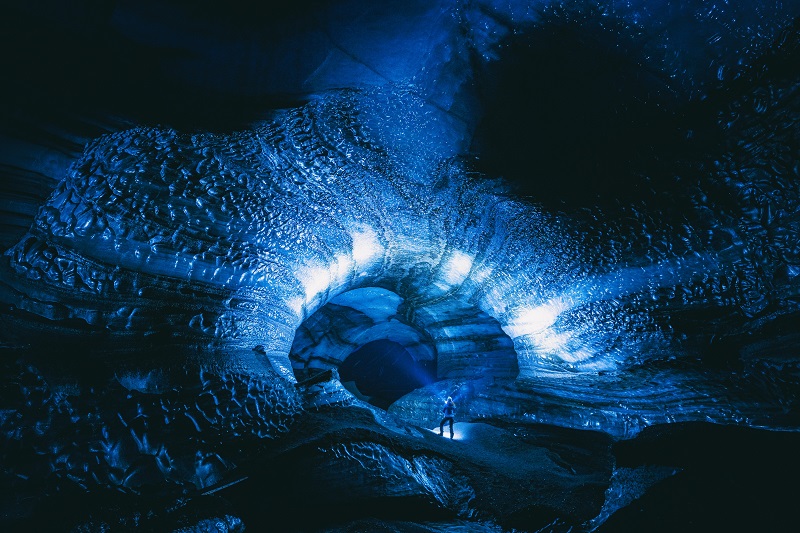
Unlike many of Iceland’s icy attractions that shut down with the change of seasons, the Katla Ice Cave is a rare gem that stays open all year round. Tours conveniently depart from Vík and whisk you away in a super jeep to the Mýrdalsjökull glacier, where this epic cave hides beneath the ice.
Once inside, you’re treated to swirling layers of black volcanic ash and pure blue ice, lit in a way that turns the whole place into a frosty kaleidoscope. The textures look like a frozen Jackson Pollock painting, the acoustics echo like a natural cathedral, and you’ll quickly see how this inspired the Netflix series (obviously simply named, Katla). It’s chilly, surreal, and straight out of a sci-fi film, only this one’s real, and you don’t need CGI goggles to enjoy it.
7. Zip-lining over Grafargil Canyon & Hundafoss Waterfall
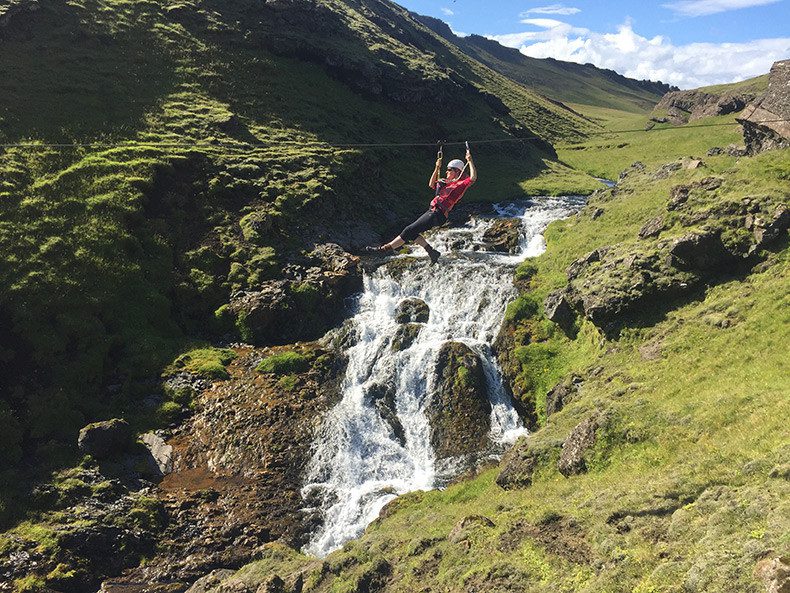
Ready for some airborne adrenaline? Vík’s zip-line tour whisks you high above Grafargil Canyon and the cascading Hundafoss waterfall, delivering a wild blend of thrills and scenery that feels like a scene out of a Bond film, minus the exploding pen. The course includes multiple zip lines of varying lengths and heights, giving you just enough time to take in the epic Icelandic landscape before you’re flying again.
The guides are knowledgeable, good fun, and make sure even the most nervous fliers feel like experienced adventurers. All the equipment is provided, the safety is top-notch, and the only thing you need to bring is a willingness to scream your lungs out while pretending you’re in an action sequence. And, if you’re feeling brave, try getting your feet above your head and going full Spider-man (I attempted…and yes…failed this when I went last).
8. Epic Hiking Trails: Reynisfjall, Hatta Mountain & Hjörleifshöfði Cape
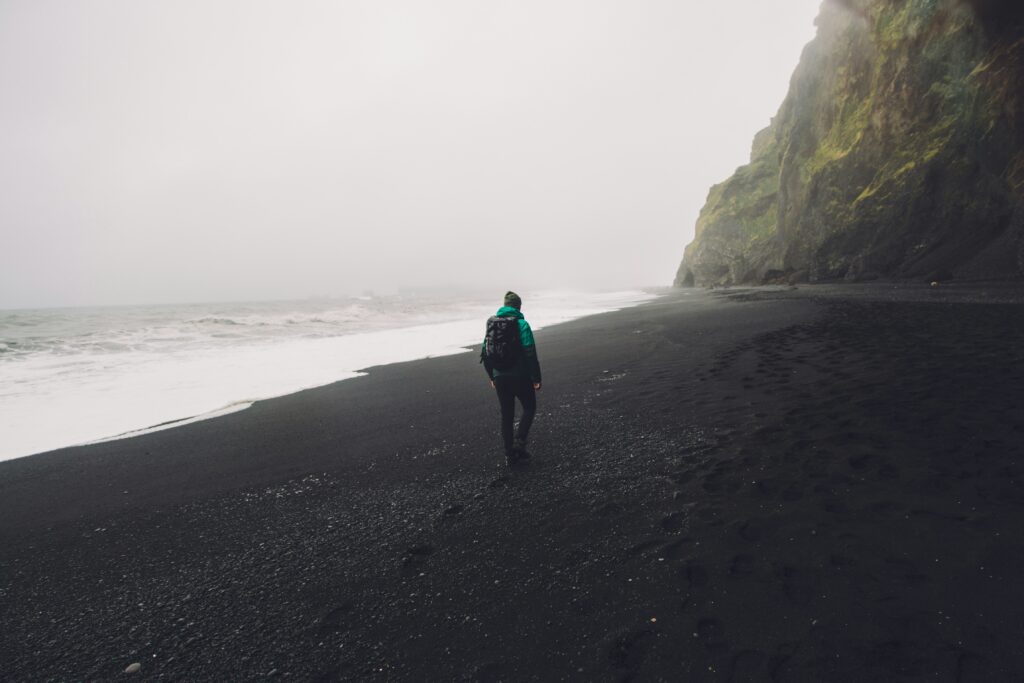
Whether you’re after a thigh-burning climb or a casual nature walk, there’s a trail for you. Reynisfjall offers puffin spotting and killer views over Reynisfjara and the Atlantic, with switchbacks that wind through lush moss and coastal cliffs.
Hatta Mountain gives you a panoramic look at the glaciers, coastline, and sweeping black sands, and on clear days, you might even spot distant volcanoes peeking above the horizon.
Then there’s Hjörleifshöfði, known as the Yoda Cave hike, which starts with an eerie flatland approach and ends in a dramatic cave carved by volcanic history. We covered the cave above, but this is a great way to take your time enjoying the journey there on foot (burning off that breakfast kleina).
9. Icelandic Lava Show: See Real Molten Lava Safely
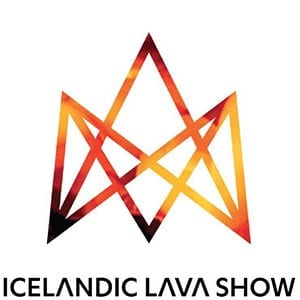
Yes, you’ll get to experience actual molten lava. Indoors. Safely.
The Icelandic Lava Show in Vík isn’t just a quirky detour, but it’s quickly become one of the most unforgettable experiences you can have in Iceland that doesn’t require hiking boots or thermal cloths prep.
They pour real lava (1100-degree-Celsius glowing-hot rock) into a room right in front of you, giving you a front-row seat to what a volcanic eruption looks and sounds like, minus the panic and evacuation alerts. You’ll hear it sizzle, feel the heat (seriously, it’s intense), and walk away with a newfound respect for the forces that shaped this wild island.
The show includes fascinating insights into Iceland’s geology from local experts who manage to make volcanic science funny and gripping. It’s the only one of its kind in the world and an absolute must for curious minds, families, and anyone who ever wondered what happens when the Earth has a bit of a meltdown. Nowadays, they also have an exhibition in Reykjavík, but Vík is the original.
10. Skaftfellingur Maritime Museum: Seafaring & Local History
Pop into this charming little museum tucked near the harbour to get the full scoop on Iceland’s gritty maritime past. The star of the show is Skaftfellingur, a beautifully restored wooden schooner that once braved the North Atlantic and now serves as a centrepiece for the exhibit.
Inside, you’ll find fascinating stories, photographs, and tools that give you a glimpse into the seafaring life that shaped this region. The museum might be small, but it’s packed with character and well-curated tales of shipwrecks, resilience, and local legends. It’s a perfect stop on a windy or rainy day, and a great way to connect with Vík’s roots beyond the lava and ice.
11. Voyages Friendship Statue: Tribute to Icelandic Seafaring Families
This bronze statue sits right by the shore and pays tribute to the hardships and bravery of Icelandic sailors and their families, who spent generations braving the icy Atlantic in pursuit of survival and sustenance. It captures the quiet strength and resilience of a seafaring culture that built much of Iceland’s coastal identity.
The surrounding area is ideal for a reflective walk, especially at golden hour when the light softens the scene and the sea breeze brings with it echoes of old maritime tales. If you’re lucky, you might catch the sound of waves crashing in sync with the statue’s silent salute to those lost at sea. And, while you’re there you might also want to try an Icelandic horse riding tour where you (and the horse, presumably) can trot along the black sands at days end.
Nature & Wildlife Encounters
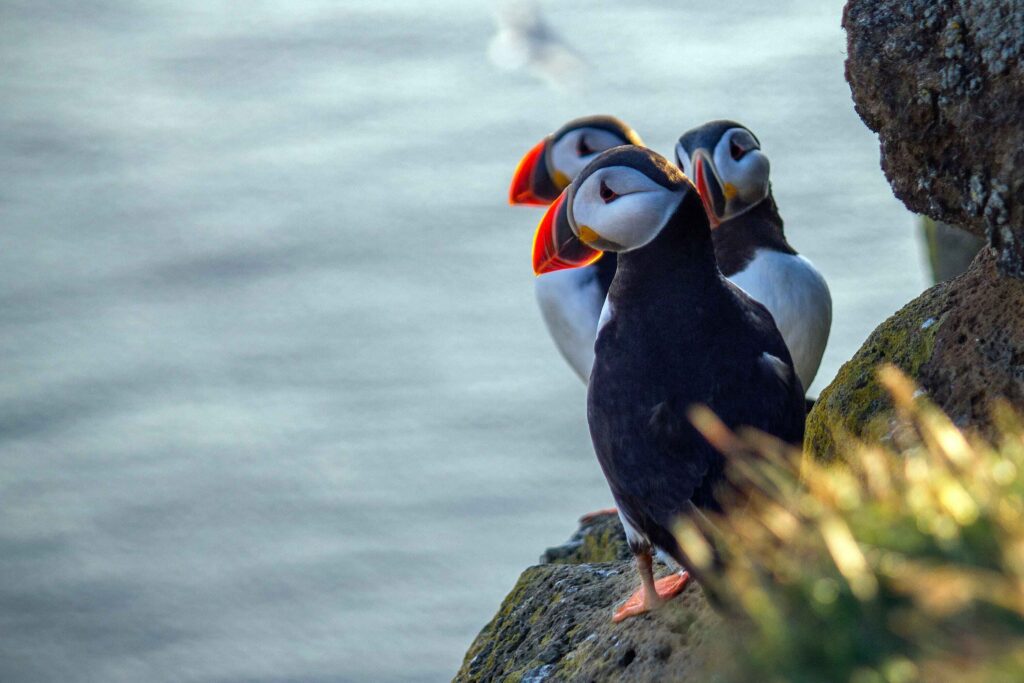
Where to Spot Puffins in Vik
Your best shot is Dyrhólaey from May to August. Look for them along the cliffs, waddling like they’re late for a comedy audition (hence why they’re known as the ‘clowns of the sea’). Their bold little beaks, fluorescent like traffic cones, are a dead giveaway even from a distance.
Just stay off the edges and respect the puffin privacy. They’ve got eggs to babysit, and the last thing they need is a human TikTok cameo causing them undue stress (or they may be critiquing the shoddy dance routine). Early morning or later in the evening tends to be best for spotting them as they flit to and from the sea with fish dangling from their beaks like overachieving parents at a buffet.
Seal Watching & Marine Life Along the Coast
While not a guaranteed sight, seals do pop up along the South Coast from time to time, especially near estuaries, river mouths, and calm coves where fish tend to be plentiful. They’re curious creatures, often bobbing their heads above the water like they’re judging your hiking outfit.
Keep your eyes peeled during beach walks, particularly in the early morning or late evening when they’re most active. Bring binoculars if you have them, and if you’re lucky, you might even spot them lounging on rocks, soaking up the same views you are, only with a bit more blubber and a lot less clothing (I assume).
Whale & Dolphin Sightings: Is Vik a Good Base?
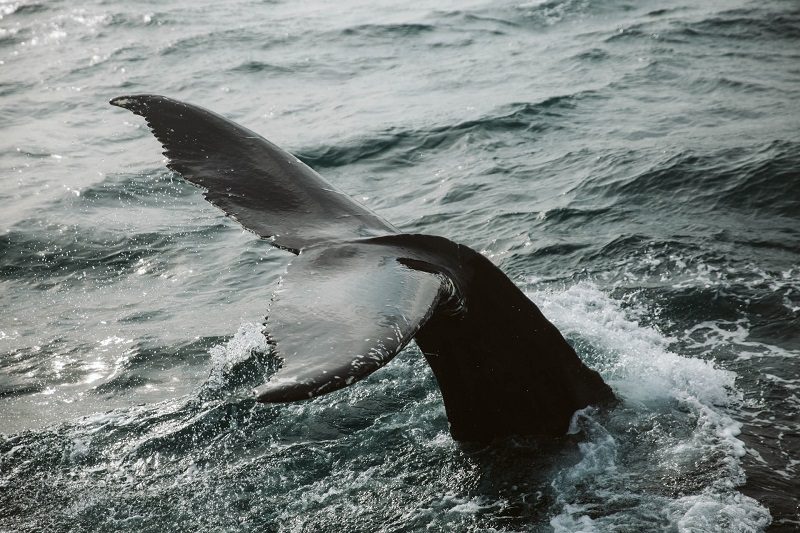
Vík isn’t exactly Iceland’s answer to SeaWorld, but every now and then, dolphins do make surprise appearances just offshore, especially on calmer days. These playful pods tend to zip along the coastline like they’re late for a meeting, so keep your eyes on the waves during beach walks or coffee breaks by the sea.
While whale sightings from Vík itself are rare, it’s not impossible to spot minke whales or even a humpback cruising past in the distance. That said, if you want a proper deep dive into whale territory, we’d recommend a detour to Húsavík, often called the whale-watching capital of Europe. Or a more convenient option is Reykjavík where you can hop on a boat tour right from the harbour. Both are a few hours’ drive from Vík but absolutely worth it if spotting marine giants is high on your Iceland bucket list – plus, I’m almost certain you won’t skip Reykjavík out of your travel plans whatever advice I give you!
Best Places to Eat in Vik
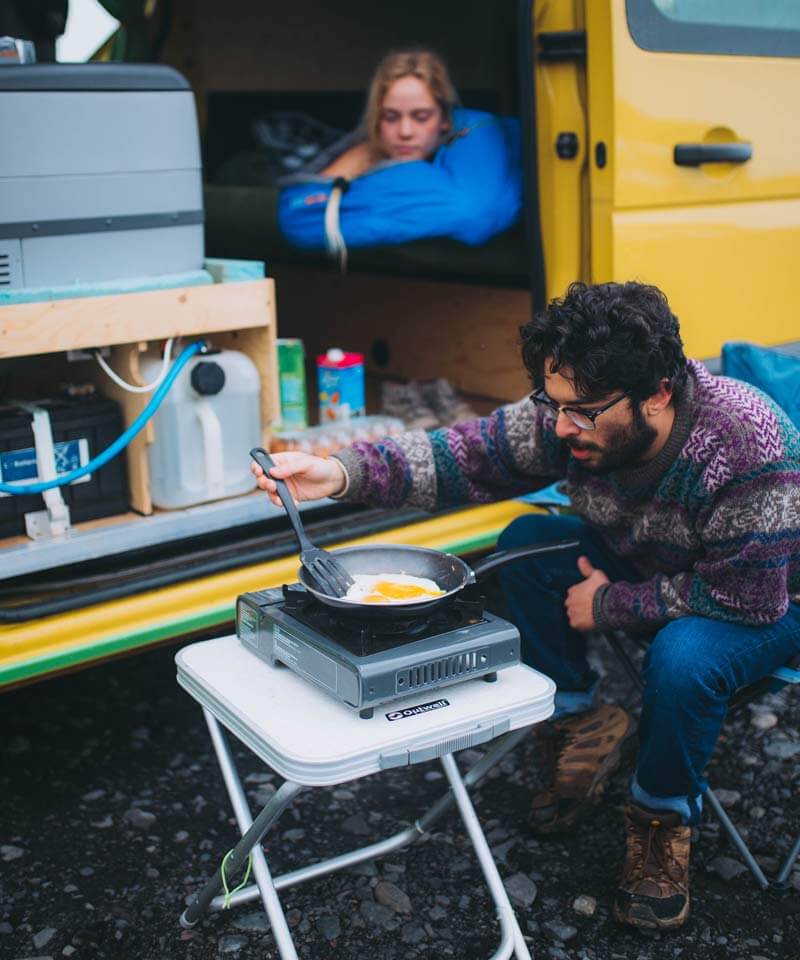
Sudur-Vik: Local Cuisine & Pizza with a View
Casual vibes, cosy interiors, and a menu that balances Icelandic favourites with a seriously good pizza game. Perfect after a day of hiking, lava-show watching, zip-lining, glacier hiking, cave dwelling…you get the idea.
Halldorskaffi: Casual Icelandic Dining
This spot is warm, friendly, and often buzzing with travellers swapping stories from the road over steaming bowls of comfort food. Try the lamb soup, a local favourite that tastes like Icelandic grandma-hugs in a bowl, or the fish of the day which is usually so fresh it practically swam onto your plate.
The quirky decor makes it feel like a laid-back living room crossed with an art project, and the atmosphere is ideal for defrosting after a day braving waterfalls and black sand beaches.
Berg Restaurant: Locally Sourced Fine Dining
If you’re feeling fancy, Berg at the Hotel Kría delivers an upscale take on Icelandic cuisine with a modern twist. Perfect for celebrating your glacier hike survival or just because you’re on holiday. It’s a little pricier, but the food and atmosphere are recommended.
Smiðjan Brugghus: Craft Brewery With a Burger
If you’re a person after my own heart, then you can’t go wrong with a few local IPA’s and no-nonsense burger at Smiðjan Brugghus. Many Icelanders are proud of their contribution to the global fun juice, and this is a very chilled one to try, and often underlooked by travellers.
Where Can I Camp in Vík?
I’ve already mentioned Vík Campsite, but if that one’s full or closed, head a little further out to Kirkjubæjarklaustur or Skógar by Skógafoss waterfall. Both offer great amenities and picturesque backdrops to wake up to.
When in doubt, check out ourcampsite map of Iceland to plan ahead.
Practical Tips for Campervan Travellers
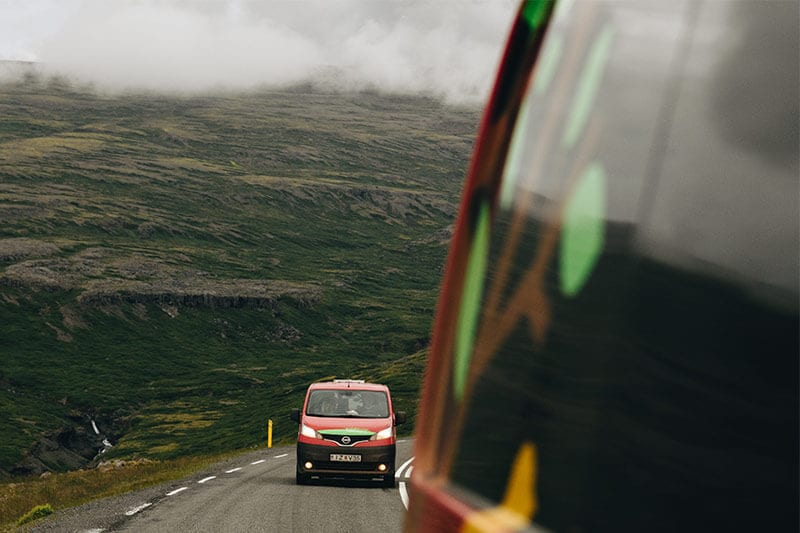
Stocking Up: Where to Find Gas, Groceries & Supplies in Vik
There’s an N1 petrol station in town with a decent selection of shops, plus a Kronan supermarket for groceries. It’s not huge, but you’ll find everything from Skyr to Lopeypeysa jumpers for souvenirs. I’d definitely recommend restocking here before heading further east.
Toilets, Showers & Amenities: What’s Available
Vík Campsite has showers and toilets for guests, and you’ll find public toilets near the petrol station and by the black sand beach parking area as part of the cafe here. Bring change or cards, as some charge a small fee for use.
Safety & Weather Sites You Should Bookmark
Always check SafeTravel.is and Vedur.is before driving or hiking. Weather changes quickly in Iceland, and what looks like “just fog” can turn into a visibility nightmare faster than you can say “volcanic ash.” With these resources you can monitor weather conditions, wind, road conditions, and even earthquakes.
Nearby Day Trips & Detours from Vik
Fjaðrárgljúfur Canyon: A Green Wonder
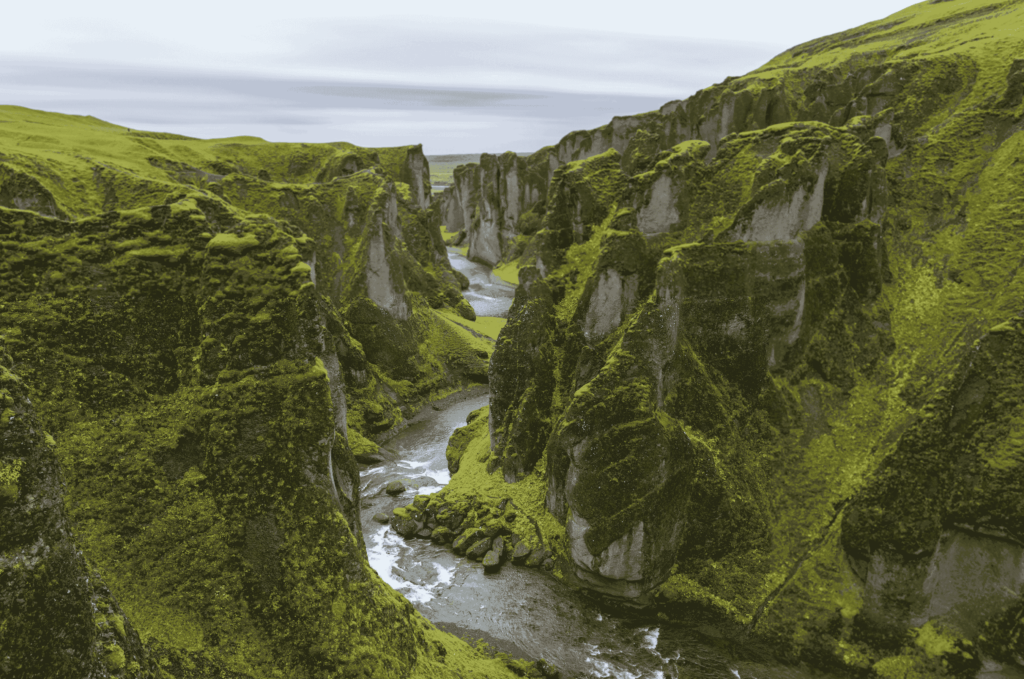
About 45 minutes east of Vík, Fjaðrárgljúfur Canyon is a moss-covered masterpiece carved over millennia by glacial meltwater. Towering up to 100 metres deep, the canyon stretches about two kilometres and offers a winding walking path along the upper rim.
As you hike, you’ll catch sweeping views of the serpentine river below and the emerald cliffs that feel plucked straight from a fantasy novel. In fact, the place is so magical that even Justin Bieber couldn’t resist filming here (which, for better or worse, put it on the global map).
Unless you’re part of Gen Alpha or found something better to do during COVID than I did, you will also notice that this canyon was in Game of Thrones season 5, in a scene with some epic flying dragons. No link to Justin Bieber.
Skógafoss & Seljalandsfoss Waterfalls
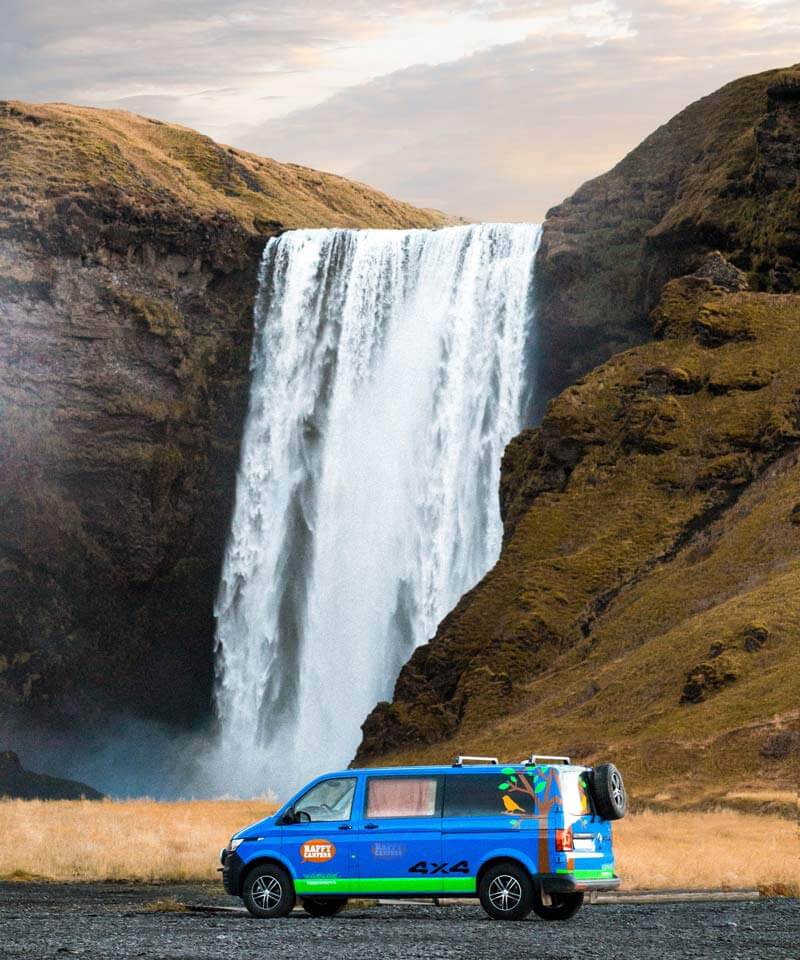
Two of the most stunning waterfalls in Iceland are within a short drive west of Vík and are absolute must-sees on any campervan adventure. Skógafoss is a towering cascade of water that crashes down with such force it creates its own misty rainbow show on sunny days. It’s one of the most photographed waterfalls in the country, and for good reason. Make sure you climb the staircase to the viewing platform at the top for panoramic views over the lush, green landscape.
As mentioned above, check out Skógafoss’s cousin, Kvernufoss – a 15-minute hike away which is way more secluded, and you can walk behind the falls (unlike Skógafoss!)
Also, around 15-minutes down the road is Seljalandsfoss, an equally mesmerising waterfall you can actually walk behind the curtain of water. The path can be slippery and you’ll most likely get at least a little wet, but it’s worth it for the view from inside the cavern looking out. Bring a raincoat, and waterproof shoes because this is one of those rare moments where nature quite literally surrounds you.
Jökulsárlón Glacier Lagoon & Diamond Beach
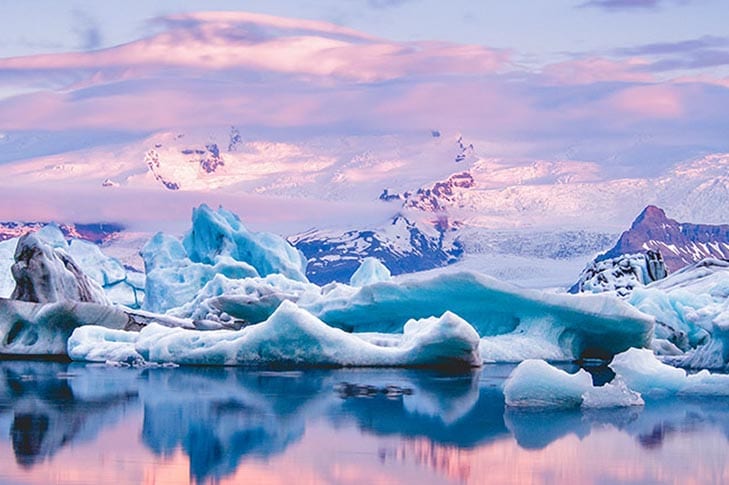
It’s a bit of a drive (around 2.5 hours east), but every twist in the road brings you closer to one of Iceland’s most jaw-dropping sights. Jökulsárlón Glacier Lagoon is like stepping into another world where huge icebergs, freshly calved from Breiðamerkurjökull glacier, float serenely through a mirror-calm lagoon. You might even spot seals weaving through the maze of ice, looking suspiciously like they’re on a sightseeing tour of their own.
Just across the road lies the famous Diamond Beach, a stretch of black volcanic sand glittering with crystal-clear ice chunks that glint like nature’s lost jewellery. It’s an incredible beach to wander through and get up close and personal with some washe dup icebergs. Be careful not to climb on them, however, as there have been occasions where travellers have been washed out to sea.
Conclusion
Vík isn’t just a stop, it’s a major highlight when exploring Iceland. From black sand drama to glacier magic, zip lines to puffins, and lava shows to scenic hikes, it’s where your campervan trip hits a whole new level.
So stock up, buckle in, and let Vík charm the woolly socks off you.
And yes, those sea stacks really do look like trolls..well, sort of!
Back